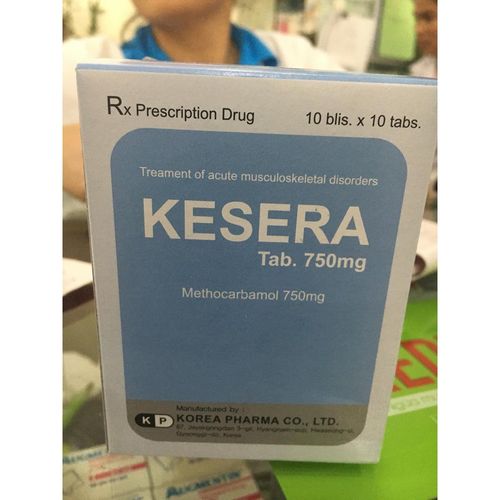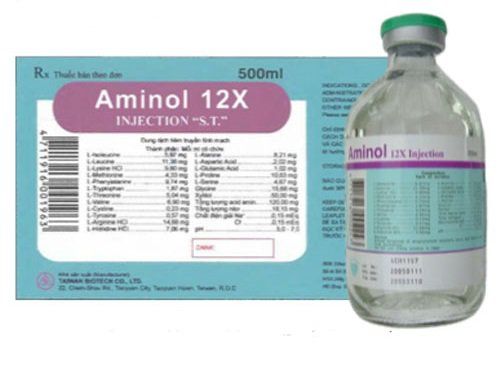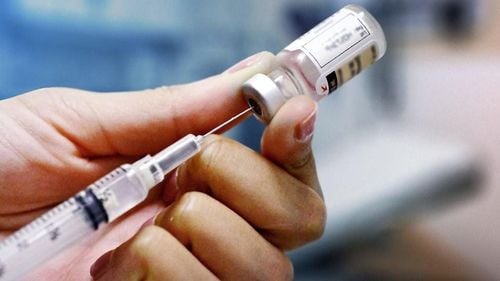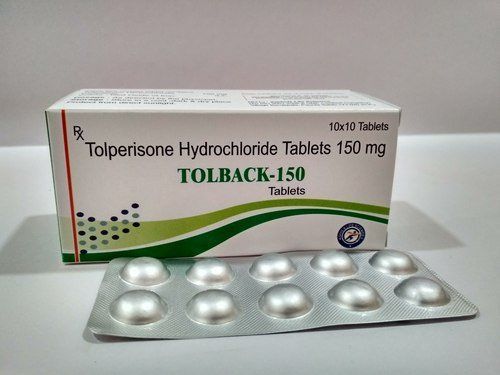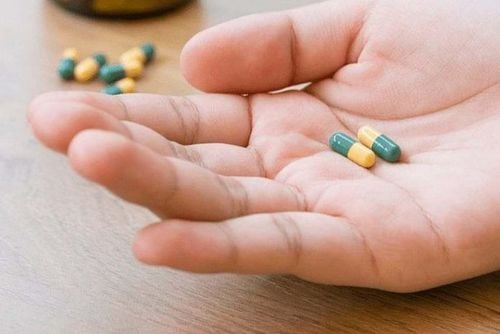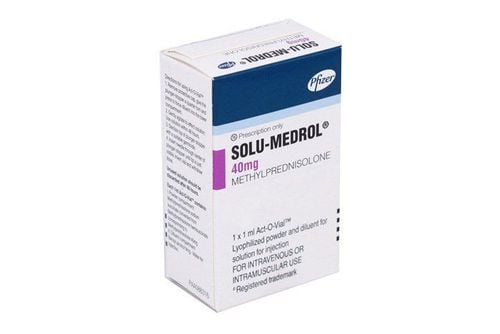This is an automatically translated article.
Baclosal 10 mg medicine has the active ingredient baclofen, which is used to relieve muscle tension and pain caused by muscle tension. The following article will provide readers with information about the uses, dosage, side effects as well as notes when using the drug.
1. What is Baclosal 10mg?
Baclosal medicine has the main ingredient is baclofen. It is used to relieve excessive muscle tension caused by conditions such as multiple sclerosis, spinal cord injury, meningeal stroke, or head trauma. In addition, the drug also helps relieve pain associated with excessive muscle tension. Baclofen belongs to the group of antispasmodics that act on the spinal cord. Baclofen is a gamma-aminobutyric acid (GABA), which reduces single- and multi-synaptic transmission at the spinal cord level, primarily by stimulation of GABA receptors. Thereby reducing the release of stimulant amino acids (glutamate and aspartate). Baclofen does not affect neuromuscular transmission. The main benefits of baclofen are due to its ability to relieve painful muscle spasms and reduce spontaneous tremor, thereby facilitating patient mobility and aiding in rehabilitation. In addition, Baclofen also works against pain perception and stimulates gastric acid secretion.
Baclofen is rapidly and almost completely absorbed from the gastrointestinal tract. Absorption may be reduced at high doses. Animal studies have shown that the drug is distributed in many tissues, but only a small amount is able to cross the blood-brain barrier. Approximately 15% of a dose of Baclofen is metabolised in the liver. Baclofen is excreted in the urine about 70-80% as unchanged or metabolized, the remainder is excreted in the feces.
2. Uses of Baclosal 10 mg
Baclosal 10 mg is indicated in the following cases:
Relieve excessive muscle tension caused by conditions such as spinal cord injury, multiple sclerosis, stroke or head trauma. Relieves pain associated with excessive muscle tension and eases muscle recovery.
3. How to take Baclosal 10 mg
Baclosal 10 mg is taken orally and the patient should take it with meals. Dosage may vary depending on the patient's condition. Here is the manufacturer's recommended reference dose:
3.1. Adults The initial dose is 5 mg (half a 10 mg tablet) 3 times a day and gradually increased every 3 days until a therapeutic effect is achieved. In most patients, the full therapeutic effect usually occurs after a dose of 30 mg - 75 mg per day. For some patients requiring higher doses (70 mg to 100 mg daily), the 25 mg tablet is recommended. The maximum dose of baclofen should not exceed 100 mg/day.
3.2. Children and adolescents under 18 years of age Should start with a low dose (0.3 mg/kg/day) in 2-4 divided doses (preferably in 4 divided doses), then gradually increase the dose until reaching desired effect, usually in the range of 0.75 - 2 mg/kg body weight. The maximum daily dose of baclofen should not exceed 40 mg in children under 8 years of age and 60 mg in children over 8 years of age. Baclofen tablets should not be given to children weighing less than 33 kg.
3.3.Patients with impaired renal function Patients with impaired renal function and patients on hemodialysis, the recommended dose should be reduced to 5 mg/day. In patients with end-stage renal failure, baclofen is used only when the benefits of treatment outweigh the risks. At the same time, patients should be closely monitored to detect early signs of drug toxicity (such as lethargy, coma).
4. Undesirable effects of the drug Baclosal 10 mg
When using Baclosal, patients may experience some unwanted effects including:
Frequency > 10%:
Gastrointestinal: Nausea, vomiting Nervous system: Confusion, dizziness, drowsiness (may be transient), headache, hypotonia Neuromuscular and skeletal: Asthenia Frequency 1 to 10%:
Cardiovascular: Hypotension, peripheral edema Dermatology: Pruritus, urticaria; Digestive: Constipation, diarrhea, hemorrhage, digestive disorders; Genitourinary system: Dysuria, impotence, urinary incontinence, urinary incontinence, urinary retention; Nervous system: Abnormal thinking, agitation, chills, coma, depression, fatigue, insomnia, pain, paresthesia, convulsions, voice disturbances; Neuromuscular and skeletal: Back pain, tremor; Ophthalmology: Decreased vision; Respiratory: Dyspnea, hypoventilation, pneumonia; Other: Accidental injury; Frequency <1%:
Cardiovascular: Ankle edema, bradycardia, chest pain, hypertension, palpitations, syncope, vasodilatation Dermatological: Alopecia, contact dermatitis, skin ulceration, hyperpigmentation skin pigmentation, rash on the skin; Endocrine and metabolic: Weight gain; Gastrointestinal: Abdominal pain, loss of appetite, dyspepsia, dysphagia, gastrointestinal bleeding, blood in stool, itchy tongue; Genitourinary system: dysuria, blood in urine, nocturia, oliguria, vaginitis; Hematology and oncology: Carcinoma, leukocytosis, purpura; Nervous system: amnesia, anxiety, ataxia, digestive disorders, blood metabolism disorders, dystonia, euphoria, hallucinations, decreased reading ability, hypothermia, hysteria, depression erectile dysfunction, irritability, personality disorder, slurred speech; Neuromuscular and skeletal: Muscle stiffness, myalgia; Ophthalmology: accommodation disorder, blurred vision, double vision, astigmatism, mydriasis, nystagmus, strabismus; Otic: Tinnitus; Kidney: Kidney stone disease; Respiratory: Apnea, nasal congestion, hypoventilation; Other: Fever (possibly high fever when smoking), increased body mass, feeling of stuffy nose; Frequency not determined:
Endocrine and metabolic: Increased serum glucose; Liver: Increased liver enzymes; Nervous system: Regressive syndrome; Cardiovascular: Deep vein thrombosis, pulmonary embolism, transient ischemic attack; Endocrine and metabolic: Decreased libido, weight loss; Digestive: Intestinal obstruction, paralytic ileus; Genitourinary: Erectile dysfunction, orgasmic disorder, foreskin stenosis; Nervous system: Delirium, disorientation;
5. Note when using Baclosal 10Mg
Baclosal 10 mg is contraindicated in patients with hypersensitivity to any of the ingredients, in patients with gastric ulcer or duodenal ulcer. Urinary retention: The drug can cause acute urinary retention (possibly related to pre-existing disease), so it should be used with caution in patients with urinary tract obstruction. Use with caution in patients with a history of idiopathic dysreflexia. Mental illness: Use with caution in patients with psychosis, schizophrenia or confusional state because the drug may aggravate the condition. Renal impairment: Use with caution in patients with renal impairment because baclofen is eliminated primarily unchanged by the kidneys. Respiratory disease: Use caution when administering baclofen to patients with respiratory disease. Seizure disorders: Convulsions have been reported in patients treated with baclofen. Therefore, baclofen should be used with caution and patients with a history of seizure disorders should be monitored. Elderly: Use with caution in elderly patients, who may be more sensitive to CNS side effects, especially at higher doses. Neonates: Neonatal withdrawal symptoms (eg, increased muscle tone, restlessness, tremors, convulsions), beginning hours to days after birth have been reported in neonates. babies born to mothers who were treated with baclofen during pregnancy. Overdose: Monitor closely for signs and symptoms of baclofen overdose. They may appear suddenly or gradually, especially during the initiation of treatment and when restarting treatment after a period of hiatus. Signs of overdose may include drowsiness, dizziness, hypothermia, respiratory depression, convulsions, decreased chest muscle tone, and loss of consciousness leading to coma. If an overdose is suspected, the patient should be taken to a medical facility immediately. Patients who drink alcohol: The use of Baclosal 10 mg may increase the sedative effect of alcohol. Therefore, patients should not drink alcohol while taking Baclosal 10 mg. Ability to drive and use machines: the drug can cause side effects such as drowsiness, sedation or fatigue. Therefore, patients taking Baclosal 10 mg should be careful when driving or operating machinery. Pregnancy: Neonatal withdrawal may occur following intrauterine exposure. Difficulty suckling, high-pitched crying, hyperthermia, hypertonia, loose stools, tremors, and convulsions have been reported in neonates following maternal use of oral baclofen during pregnancy. Therefore, pregnant patients should consult their doctor before using the drug. The manufacturer recommends that Baclosal 10 mg be used during pregnancy only when your doctor has considered that its use is absolutely necessary. Lactation: Baclofen is present in breast milk. Withdrawal symptoms may occur in a nursing infant, when the mother stops taking baclofen or stops breastfeeding. According to the manufacturer, the decision to breastfeed during treatment should consider the risk of exposure to the infant, the benefits of breastfeeding, and the effect of treatment on the mother. Drug Interactions: Baclofen when used concurrently with certain drugs may decrease effectiveness or increase side effects. For example, the combination of baclofen with antidepressants such as clomipramine, amitriptyplin can cause marked myasthenia gravis. Therefore, patients need to inform their doctors and pharmacists of all medicines and dietary supplements they are using for advice on appropriate medication use. In summary, Baclosal is used to treat excessive muscle tension and pain caused by muscle tension. Medicines can cause many side effects if not used correctly. Therefore, patients should consult medical personnel before use.
Follow Vinmec International General Hospital website to get more health, nutrition and beauty information to protect the health of yourself and your loved ones in your family.
Please dial HOTLINE for more information or register for an appointment HERE. Download MyVinmec app to make appointments faster and to manage your bookings easily.




